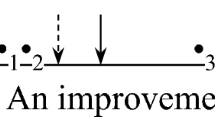Abstract
This paper shows that a relatively easy algorithm for computing the (unique) outcome of a sophisticated voting procedure called sequential voting by veto (SVV) applies to a more general situation than considered hitherto. According to this procedure a sequence of n voters must select s out of m + s options (s > 0, m 3 ⩾ n 3 ⩾ 2). The ith voter, when his turn comes, vetoes k i options (k i ⩾ 1, ∑ k i = m). The s remaining non-vetoed options are selected. Every voter is assumed to be fully informed of all other voters total (linear) preference orderings among the competing options, as well as of the order in which the veto votes are cast. This algorithm was proposed by Mueller (1978) for the special case where s and the k i are all equal to 1, and extended by Moulin (1983) to the somewhat more general case where the k i are arbitrary but s is still 1. Some theoretical and practical issues of voting by veto are discussed.
Similar content being viewed by others
References
Banks, J. S.: 1985, ‘Sophisticated Voting Outcomes and Agenda Control’, Social Choice and Welfare 1, 295–306.
Farquharson, R.: 1969, Theory of Voting, New Haven, CT.: Yale University Press.
Felsenthal, D. S. and Maoz, Z.: 1992, ‘Normative Properties of Four Single-Stage Multi-Winner Electoral Procedures’, Behavioral Science 37, 109–127.
Jung, J. P.: 1990, ‘Black and Farquharson on Order-of-Voting Effects’, Social Choice and Welfare 7, 319–329.
Lijphart, A. and Grofman, B.: 1984, ‘Choosing an Electoral System’, in: Lijphart, A. and Grofman, B. (Eds.), Choosing an Electoral System: Issues and Alternatives, New York: Praeger.
McKelvey, R. D. and Niemi, R. G.: 1978, ‘A Multistage Game Representation of Sophisticated Voting for Binary Procedures’, Journal of Economic Theory 18, 1–22.
Moulin, H.: 1981, ‘Prudence Versus Sophistication in Voting Strategy’, Journal of Economic Theory 24, 398–412.
Moulin, H.: 1983, The Strategy of Social Choice, Amsterdam: North-Holland.
Mueller, D. C.: 1978, ‘Voting by Veto’, Journal of Public Economics 10, 57–75.
Ordeshook, P. C. and Palfrey, T. R.: 1988, ‘Agendas, Strategic Voting, and Signaling with Incomplete Information’, American Journal of Political Science 32, 441–466.
Pattanaik, P.: 1978, Strategy and Group Choice, Amsterdam: North-Holland.
Author information
Authors and Affiliations
Rights and permissions
About this article
Cite this article
Dan Felsenthal, S., Machover, M. Sequential voting by veto: Making the Mueller-Moulin algorithm more versatile. Theor Decis 33, 223–240 (1992). https://doi.org/10.1007/BF00133642
Issue Date:
DOI: https://doi.org/10.1007/BF00133642




